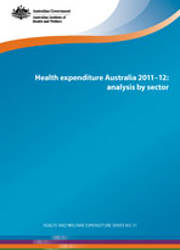Summary
This report extends the analysis presented in Health expenditure Australia 2011-12 to further explore expenditure on particular categories of health goods and services, including hospitals, primary health care, other recurrent health expenditure and capital expenditure.
Over the decade from 2001-02 to 2011-12, expenditure increased in real terms for all areas of expenditure: from $31.0 billion to $53.5 billion for hospitals; from $30.8 billion to $50.6 billion for primary health care; from $16.9 billion to $28.3 billion for other recurrent health expenditure; and from $4.2 billion to $7.9 billion for capital expenditure.
Growth did not occur at the same rate for all areas of expenditure. Between 2001-02 and 2005-06, the share of recurrent expenditure attributed to hospitals increased from 39.4% to 40.6%. The share for primary health care decreased over this time from 39.1% to 37.8%. No clear trend has been evident for expenditure in these areas since 2005-06. In 2011-12, hospitals comprised 40.4% of recurrent expenditure and primary health care comprised 38.2%.
The changing proportions of health expenditure are affected by the sources of funds (i.e. who is paying) and the decisions and agreements made about funding levels. In recent years, the relative share of Australian Government funding directed towards primary health care has increased while the share directed towards hospitals has decreased. Between 2001-02 and 2003-04, for every $1 the Australian Government spent on hospitals, it spent on average $0.97 on primary health care. In 2011-12, the Australian Government spent around $1.16 on primary health care for every $1 it provided for hospitals. In contrast, the state and territory governments increased the share of their recurrent expenditure allocated to hospitals from 63.0% to 69.0% over the decade and decreased the share allocated to primary health care from 29.1% to 21.4%.
Between 2001-02 and 2011-12, total growth in state and territory government funding for hospitals ($11.5 billion) was almost double (1.8 times) that of the Australian Government ($6.2 billion) and 2.4 times non-government expenditure growth ($4.8 billion).
Expenditure trends also varied between the states and territories. Western Australia had the largest growth in state government funding for hospitals, more than doubling (2.16 times) its expenditure on hospitals between 2001-02 and 2011-12. Average annual growth in Victoria (4.3%) and New South Wales (4.8%) was below the national average of 5.6%.
The Northern Territory went from having the lowest Australian Government funding on health per person in 2001-02 ($1,697) to the highest in 2011-12 ($3,379). Western Australia had the slowest growth in Australian Government funding per person. In 2011-12, Western Australia had the lowest Australian Government expenditure at $2,270 per person ($350 lower than the national average).
Per person health expenditure by the Western Australia government was 2.5 times larger in 2011-12 ($2,219) than in 2001-02 ($891). South Australia, the Northern Territory and the Australian Capital Territory also more than doubled their per person expenditure between 2001-02 and 2011-12. Non-government expenditure was the highest in Victoria in both 2001-02 ($1,550 per person) and 2011-12 ($2,165 per person). In 2001-02, the Northern Territory was $393 per person below the national average while in 2011-12 it was $596 per person below the national average.



